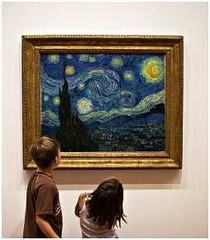by Amy M. O’Quinn

Classical music. Art Appreciation. Nature Study. Poetry and Shakespeare. These areas of study may sound like complicated courses that are best left alone until the high school or college years, but young children can certainly benefit from an acquaintance with the fine arts as well. As parents, we all want our children to be well rounded and educated to the best of our abilities. We expect teachers (or ourselves if we homeschool) to cover the basics such as reading, writing, and arithmetic, but there is also something so satisfying about recognizing a Monet or a Cezanne, or hearing and identifying music composed by Mozart or Tchaikovsky.
There is joy in taking a walk, finding a special leaf to sketch in a nature journal, and later discovering in a field guide that it belongs to an aspen tree. And who hasn’t heard or read a common phrase (such as green-eyed monster) that can be traced back to the pen of William Shakespeare?
Why Study Fine Arts?
Charlotte Mason, a 19th century British educator, believed that exposing children to great ideas and beauty in all areas inspired them to greatness as well. She theorized that by letting them become familiar with the best artists, composers, and writers, they would be less willing to settle for mediocrity in themselves. As Elizabeth Gutman said in her book, The Story of Art, part of The Bookshelf for Boys and Girls series:
“The magic power of art can arouse all kinds of emotions in us, from simple joy to much deeper feelings. And artists are great people whose works can gladden our eyes, enrich our thoughts, and deepen our feelings.”
I think these words can apply to ALL areas of the fine arts. And with today’s norm of following the crowd or being happy with the status quo, we should want our children to be inspired and motivated to strive for more—to reach for excellence instead of being content with the marginal.
In my monthly contribution to the “Parenting and Teaching Tip” column over the next few weeks, I’d like to explore some of these areas in more depth. But for this particular column, I will focus on “picture study”, which is one facet of art appreciation.
Picture Study
Introducing a new artist or a specific piece of art is very easy to do. Many websites have lists of suggested artist rotations, but it’s better to choose one artist’s work to study at a time so the child can become familiar with the style and at least four of his/her pieces of artwork. My twelve-year-old son recently studied the work of Mary Cassatt, and he can now easily recognize her paintings.
We began our study of Mary Cassatt by reading more about her life in a biography. Then I had him focus only on her painting, Children On the Beach (1884). I let him study the picture for several minutes, then I turned it over and asked him to describe what he remembered about the painting, even the little details. Afterwards, we turned the picture back over to see how well he’d seen it all in his ‘mind’s eye.’ We talked about the medium used, the colors, the subjects, etc. We did this for several days, and each time he remembered more and more about the painting. On another occasion, I had him try to re-create the painting himself from memory. Although not a natural artist, he did quite well! We went on to study three more of her paintings before moving on to a new artist.
On another note, I had a large framed poster of Children On the Beach hanging in my children’s bathroom. When my little ones (ages 2 and 4) took a bath, we would look at the painting and talk about it. It’s amazing how much they learned about Mary Cassatt’s work in just a few minutes each night! They remembered almost as much as their older brother, and it was just that simple.
Some people choose to make artists t


